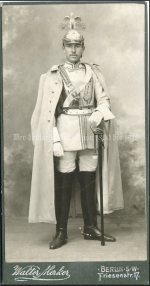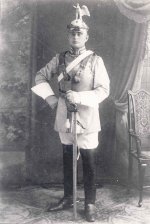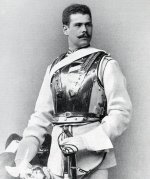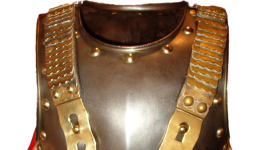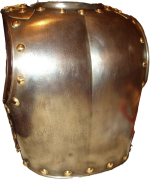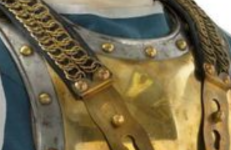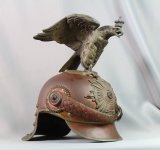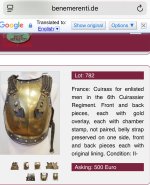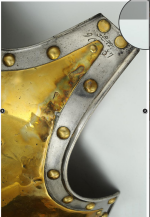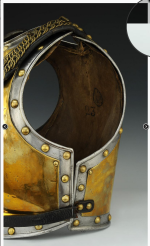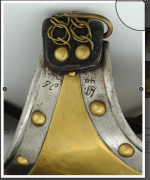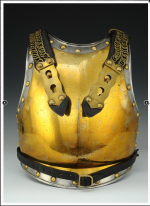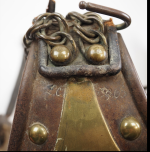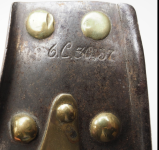You are using an out of date browser. It may not display this or other websites correctly.
You should upgrade or use an alternative browser.
You should upgrade or use an alternative browser.
Garde Kürassier Regiment Kürass
- Thread starter brusik1
- Start date
Khukri
Well-known member
In 1814 the Prussian Army counted four Cuirassier Regiments: The Gardes du Corps; the Brandenburgisches (later the number 6); The Schlesisches and the Ost Preussisches (later the Regiments numbers 1 and 3).
-A large stock of French cuirasses was captured (Paris and Versailles): A.K.O of 21. April 1814 allowed the use of these cuirasses. The Carabinier pattern (brass plated). ; "Yellow" for the G d C Regt and the Brandenburgisches Regt; The Schlesisches and the Ost Preussisches were equipped with the steel pattern.
-With the formation of the Garde Ku Regt the Brandenburgisches Nr.6 had to hand over its yellow cuirasses. Both G d C and Garde Ku will keep the chain shoulder straps. All other Regiments will have to wear the scaled straps.
-Regiment Nr 6: Officers and Uffz will keep wearing the Yellow pattern; with the scales on the shoulder bands.
-The new Regt "Königin" Nr.2: Officers and Unteroffiziere: Yellow plated pattern; Scales on the shoulder bands.
In order to fill the gaps in the demand for Kurassen the Ersatz pattern was produced; Identical to the French patterns (spoils of war). Tombac instead of brass for the skin of the yellow pattern.
*Problem:
1-the neck and arm cut-outs were too narrow. There were accidents recorded with Kürassiers breaking their neck when falling from their horse. Combination of narrow neck cut-out and the large helmet neck guard.
2-arm cut-outs only had rolled edges. No "Stichblatt".
-The Stichblatt*/board; protected against sword/sabre trusts gliding off their armour. Difficult to translate: "Stich": a stab; "Blatt": guarding edge.
Both issues were taken in consideration when developing the new pattern.
From the J-L. Larcade Archive: Kürassier binders.
*Pictures: Other Ranks. Stamped FWR: [König Friedrich Wilhelm died in 1861].
-Pictures 1 and 2: Note the Stichblatt* around neck- and arm cut-outs.
-Picture 3: French M 1807 Carabinier pattern: Compare: No guarding edge around neck- and arm cut-outs.
probably many of this pattern became spoils of war in 1814.
Between 1881 and 1885 the name Cürassier will be changed to Kürassier.
Georg Petschke
discribes the following six patterns in detail:
-#1: First: the white iron cuirass, spoils of war from 1814.
-#2: second: the iron cuirass set with a yellow brass plate/skin, again from the spoils of war 1814. Chain straps.
#3:The blackened iron cuirass Donated by the Russian Tsar in 1814 to the GdC Regiment
-in 1897 Kaiser Wilhelm II donated a new, more elegant pattern of the black cuirass.
#4 Similar to number two but with scaly straps
#5 The Fifth: Cast Steel Cuirass *Muster/Pattern 1845
#6 Sixth: cast steel cuirass with the yellow brass plates Muster 1845
-A large stock of French cuirasses was captured (Paris and Versailles): A.K.O of 21. April 1814 allowed the use of these cuirasses. The Carabinier pattern (brass plated). ; "Yellow" for the G d C Regt and the Brandenburgisches Regt; The Schlesisches and the Ost Preussisches were equipped with the steel pattern.
-With the formation of the Garde Ku Regt the Brandenburgisches Nr.6 had to hand over its yellow cuirasses. Both G d C and Garde Ku will keep the chain shoulder straps. All other Regiments will have to wear the scaled straps.
-Regiment Nr 6: Officers and Uffz will keep wearing the Yellow pattern; with the scales on the shoulder bands.
-The new Regt "Königin" Nr.2: Officers and Unteroffiziere: Yellow plated pattern; Scales on the shoulder bands.
In order to fill the gaps in the demand for Kurassen the Ersatz pattern was produced; Identical to the French patterns (spoils of war). Tombac instead of brass for the skin of the yellow pattern.
*Problem:
1-the neck and arm cut-outs were too narrow. There were accidents recorded with Kürassiers breaking their neck when falling from their horse. Combination of narrow neck cut-out and the large helmet neck guard.
2-arm cut-outs only had rolled edges. No "Stichblatt".
-The Stichblatt*/board; protected against sword/sabre trusts gliding off their armour. Difficult to translate: "Stich": a stab; "Blatt": guarding edge.
Both issues were taken in consideration when developing the new pattern.
From the J-L. Larcade Archive: Kürassier binders.
*Pictures: Other Ranks. Stamped FWR: [König Friedrich Wilhelm died in 1861].
-Pictures 1 and 2: Note the Stichblatt* around neck- and arm cut-outs.
-Picture 3: French M 1807 Carabinier pattern: Compare: No guarding edge around neck- and arm cut-outs.
probably many of this pattern became spoils of war in 1814.
Between 1881 and 1885 the name Cürassier will be changed to Kürassier.
Georg Petschke
discribes the following six patterns in detail:
-#1: First: the white iron cuirass, spoils of war from 1814.
-#2: second: the iron cuirass set with a yellow brass plate/skin, again from the spoils of war 1814. Chain straps.
#3:The blackened iron cuirass Donated by the Russian Tsar in 1814 to the GdC Regiment
-in 1897 Kaiser Wilhelm II donated a new, more elegant pattern of the black cuirass.
#4 Similar to number two but with scaly straps
#5 The Fifth: Cast Steel Cuirass *Muster/Pattern 1845
#6 Sixth: cast steel cuirass with the yellow brass plates Muster 1845
Attachments
Last edited:
brusik1
Well-known member
What did the Guard Cuirassier Regiment, Squadron No. 3 wear?In 1814 the Prussian Army counted four Cuirassier Regiments: The Gardes du Corps; the Brandenburgisches (later the number 6); The Schlesisches and the Ost Preussisches (later the Regiments numbers 1 and 3).
-A large stock of French cuirasses was captured (Paris and Versailles): A.K.O of 21. April 1814 allowed the use of these cuirasses. The Carabinier pattern (brass plated). ; "Yellow" for the G d C Regt and the Brandenburgisches Regt; The Schlesisches and the Ost Preussisches were equipped with the steel pattern.
-With the formation of the Garde Ku Regt the Brandenburgisches Nr.6 had to hand over its yellow cuirasses. Both G d C and Garde Ku will keep the chain shoulder straps. All other Regiments will have to wear the scaled straps.
-Regiment Nr 6: Officers and Uffz will keep wearing the Yellow pattern; with the scales on the shoulder bands.
-The new Regt "Königin" Nr.2: Officers and Unteroffiziere: Yellow plated pattern; Scales on the shoulder bands.
In order to fill the gaps in the demand for Kurassen the Ersatz pattern was produced; Identical to the French patterns (spoils of war). Tombac instead of brass for the skin of the yellow pattern.
*Problem:
1-the neck and arm cut-outs were too narrow. There were accidents recorded with Kürassiers breaking their neck when falling from their horse. Combination of narrow neck cut-out and the large helmet neck guard.
2-Neck and arm cut-outs only had rolled edges. No "Stichblatt".
-The Stichblatt*/board; protected against sword/sabre trusts gliding off their armour. Difficult to translate: "Stich": a stab; Blatt: guarding edge.
Both issues were taken in consideration when developing the new pattern.
From the J-L. Larcade Archive: Kürassier binders.
*Pictures: Other Ranks. Stamped FWR: [König Friedrich Wilhelm died in 1861].
Note the Stichblatt* around neck- and arm cut-outs.
Between 1881 and 1885 the name Cürassier will be changed to Kürassier.
Georg Petschke
discribes the following six patterns in detail:
-#1: First: the white iron cuirass, spoils of war from 1814.
-#2: second: the iron cuirass set with a yellow brass plate/skin, again from the spoils of war 1814. Chain straps.
#3:The blackened iron cuirass Donated by the Russian Tsar in 1814 to the GdC Regiment
#4 Similar to number two but with scaly straps
#5 The Fifth: Cast Steel Cuirass *Muster/Pattern 1845
#6 Sixth: cast steel cuirass with the yellow brass plates Muster 1845
Khukri
Well-known member
Indeed!Tony S has a wonderful example.
Khukri
Well-known member
"Yellow" with the chain straps.What did the Guard Cuirassier Regiment, Squadron No. 3 wear?
#6 in Georg Petschke's list.
2nd.Leibhusar
Well-known member
"why I ask it, because I am looking for a suitable cuirasse for my helmet"
Bene Merenti has one for sale in it's upcoming auction I think
Bene Merenti has one for sale in it's upcoming auction I think
KAGGR#1
Well-known member
FrancisIn 1814 the Prussian Army counted four Cuirassier Regiments: The Gardes du Corps; the Brandenburgisches (later the number 6); The Schlesisches and the Ost Preussisches (later the Regiments numbers 1 and 3).
-A large stock of French cuirasses was captured (Paris and Versailles): A.K.O of 21. April 1814 allowed the use of these cuirasses. The Carabinier pattern (brass plated). ; "Yellow" for the G d C Regt and the Brandenburgisches Regt; The Schlesisches and the Ost Preussisches were equipped with the steel pattern.
-With the formation of the Garde Ku Regt the Brandenburgisches Nr.6 had to hand over its yellow cuirasses. Both G d C and Garde Ku will keep the chain shoulder straps. All other Regiments will have to wear the scaled straps.
-Regiment Nr 6: Officers and Uffz will keep wearing the Yellow pattern; with the scales on the shoulder bands.
-The new Regt "Königin" Nr.2: Officers and Unteroffiziere: Yellow plated pattern; Scales on the shoulder bands.
In order to fill the gaps in the demand for Kurassen the Ersatz pattern was produced; Identical to the French patterns (spoils of war). Tombac instead of brass for the skin of the yellow pattern.
*Problem:
1-the neck and arm cut-outs were too narrow. There were accidents recorded with Kürassiers breaking their neck when falling from their horse. Combination of narrow neck cut-out and the large helmet neck guard.
2-Neck and arm cut-outs only had rolled edges. No "Stichblatt".
-The Stichblatt*/board; protected against sword/sabre trusts gliding off their armour. Difficult to translate: "Stich": a stab; "Blatt": guarding edge.
Both issues were taken in consideration when developing the new pattern.
From the J-L. Larcade Archive: Kürassier binders.
*Pictures: Other Ranks. Stamped FWR: [König Friedrich Wilhelm died in 1861].
-Pictures 1 and 2: Note the Stichblatt* around neck- and arm cut-outs.
-Picture 3: French M 1807 Carabinier pattern: Compare: No guarding edge around neck- and arm cut-outs.
probably many of this pattern became spoils of war in 1814.
Between 1881 and 1885 the name Cürassier will be changed to Kürassier.
Georg Petschke
discribes the following six patterns in detail:
-#1: First: the white iron cuirass, spoils of war from 1814.
-#2: second: the iron cuirass set with a yellow brass plate/skin, again from the spoils of war 1814. Chain straps.
#3:The blackened iron cuirass Donated by the Russian Tsar in 1814 to the GdC Regiment
#4 Similar to number two but with scaly straps
#5 The Fifth: Cast Steel Cuirass *Muster/Pattern 1845
#6 Sixth: cast steel cuirass with the yellow brass plates Muster 1845
I have a set of 35mm color slides of the Georg Petschke
collection that were taken by my late collector friend from Sweden
Jarl Hartze before Petschke passed away and Kube sold the collection
Steve
Khukri
Well-known member
Very interesting!!Francis
I have a set of 35mm color slides of the Georg Petschke
collection that were taken by my late collector friend from Sweden
Jarl Hartze before Petschke passed away and Kube sold the collection
Steve
Doug B
Well-known member
Khukri
Well-known member
On this one that will be on auction later this month: The French 1814 captured cuirass had brass skin. The later; Prussian made; had the Tombac skin.
-I think the Kammer Stempel in the shoulder is G.C. Garde Cürassiere; not 6.C...
-only The Gardes du Corps and the Garde Kürassier Regiment had the chains on the straps.
-And at the left shoulder strap we see the brass 5mm thick pen. Forming a hook that prevents the bandolier belt from rubbing against the collar of the Koller and the wearers neck. [As of 1830].
-the thick leather-one piece-straps are riveted to be back plate. No hinges.
-later these will consist of two parts: the short piece that was riveted to the back plate where the leather shoulder strap with the two rows of chains was connected to; forming a swivel.
-Both brass knobs-on the breastplate-where the straps brass endpieces are hooked on, are placed lower.
-could be a Prussian production; "Ersatz" to fill the missing equipment. 1814-1845. Still without Stichblat around the arm cut-outs...these Ersatz have the Stichblat only on the neck cut-out of the breastplate!
-These "Ersatz" differ from the 1814 French cuirass by that Stichblat on the neck cut-out of the breast plate.
-1840: these 1814 and the Ersatz became unmodern. And...last but not least: the soft iron proved to offer no protection anymore against the firearms of that era. Keeping in mind that these had been developed to withstand the musket balls fired from smooth bore flintlock muskets. In the meanwhile rifle; projectile and powder had been evolved.
-The 1814 spoils of war would have the French forgery and makers marks. The auctioneer is listing this piece as French...
-I think the Kammer Stempel in the shoulder is G.C. Garde Cürassiere; not 6.C...
-only The Gardes du Corps and the Garde Kürassier Regiment had the chains on the straps.
-And at the left shoulder strap we see the brass 5mm thick pen. Forming a hook that prevents the bandolier belt from rubbing against the collar of the Koller and the wearers neck. [As of 1830].
-the thick leather-one piece-straps are riveted to be back plate. No hinges.
-later these will consist of two parts: the short piece that was riveted to the back plate where the leather shoulder strap with the two rows of chains was connected to; forming a swivel.
-Both brass knobs-on the breastplate-where the straps brass endpieces are hooked on, are placed lower.
-could be a Prussian production; "Ersatz" to fill the missing equipment. 1814-1845. Still without Stichblat around the arm cut-outs...these Ersatz have the Stichblat only on the neck cut-out of the breastplate!
-These "Ersatz" differ from the 1814 French cuirass by that Stichblat on the neck cut-out of the breast plate.
-1840: these 1814 and the Ersatz became unmodern. And...last but not least: the soft iron proved to offer no protection anymore against the firearms of that era. Keeping in mind that these had been developed to withstand the musket balls fired from smooth bore flintlock muskets. In the meanwhile rifle; projectile and powder had been evolved.
-The 1814 spoils of war would have the French forgery and makers marks. The auctioneer is listing this piece as French...
Last edited:
KAGGR#1
Well-known member
I am looking for ways to transfer the 35 mm color slides of the former collectionVery interesting!!
That sale was the "big jump start " for Kube
Steve
Doug B
Well-known member
There are companies that will digitize and even enhance 35mm slides.I am looking for ways to transfer the 35 mm color slides of the former collection
That sale was the "big jump start " for Kube
Steve
Khukri
Well-known member
Good luck!I am looking for ways to transfer the 35 mm color slides of the former collection
That sale was the "big jump start " for Kube
Steve
brusik1
Well-known member
Hello again, I found a similar cuirasses online,from an auction house. The cuirasses has similar stamps, maker "DOBBELAER," so it appears to be a French cuirasses.Here is a text from the auction house:
"
CUIRASSE TROUPE DE CARABINIERS, MODÈLE 1810, PREMIER EMPIRE.
En fer, recouverte d’une feuille de laiton laissant sur les côtés une bordure en fer apparent garnie de 33 clous en laiton sur le plastron et 32 clous sur la dossière, plus 4 clous pour la ceinture.
Plastron à arête saillante, col bordé d’une gouttière, emmanchures bordées d’un bourrelet, forme arrondie dans le bas. Poinçonnée « DOBBELAER / 3C 72 barré / 9C 37» (ou 57 ?) et sur un côté « AP »
Dossière bordée de bourrelets. Épaulières entièrement en laiton, constituées de deux chaînettes gourmettes en laiton terminées par une serrure en laiton avec patte en cuir. Poinçonnée pour l'épaulière gauche « 3C 61 barré au profit de 9C 57 », et « AP » sur le côté.
Doublure en toile avec poche ventrale portant des numéros à la plume « 12, 920 », au-dessus de cette poche une étiquette papier est collée avec le matricule « 37 » correspondant au matricule de la cuirasse le nom en partie lisible « Ginpe…l ». La doublure de la dossière cachet circulaire (cachet régimentaire ?) et la chiffre « 23 ».
Très bon état.
France.
"
"
CUIRASSE TROUPE DE CARABINIERS, MODÈLE 1810, PREMIER EMPIRE.
En fer, recouverte d’une feuille de laiton laissant sur les côtés une bordure en fer apparent garnie de 33 clous en laiton sur le plastron et 32 clous sur la dossière, plus 4 clous pour la ceinture.
Plastron à arête saillante, col bordé d’une gouttière, emmanchures bordées d’un bourrelet, forme arrondie dans le bas. Poinçonnée « DOBBELAER / 3C 72 barré / 9C 37» (ou 57 ?) et sur un côté « AP »
Dossière bordée de bourrelets. Épaulières entièrement en laiton, constituées de deux chaînettes gourmettes en laiton terminées par une serrure en laiton avec patte en cuir. Poinçonnée pour l'épaulière gauche « 3C 61 barré au profit de 9C 57 », et « AP » sur le côté.
Doublure en toile avec poche ventrale portant des numéros à la plume « 12, 920 », au-dessus de cette poche une étiquette papier est collée avec le matricule « 37 » correspondant au matricule de la cuirasse le nom en partie lisible « Ginpe…l ». La doublure de la dossière cachet circulaire (cachet régimentaire ?) et la chiffre « 23 ».
Très bon état.
France.
"
Attachments
brusik1
Well-known member
May I ask if we can look at some slides?Francis
I have a set of 35mm color slides of the Georg Petschke
collection that were taken by my late collector friend from Sweden
Jarl Hartze before Petschke passed away and Kube sold the collection
Steve
Thanks
kuerassier
Well-known member
The description is correct; Dobbelaer is a well-known manufacturer from the Napoleonic era.
The brass bow or clasp for the bandolier is typical of Prussia. The French didn't have anything like it.
That means this cuirass was captured by the Prussians and continued to be used until a new model was introduced in 1845.
The brass bow or clasp for the bandolier is typical of Prussia. The French didn't have anything like it.
That means this cuirass was captured by the Prussians and continued to be used until a new model was introduced in 1845.

